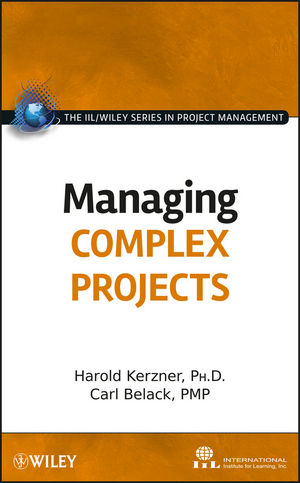Managing Complex ProjectsISBN: 978-0-470-60034-4
Hardcover
416 pages
September 2010
 |
||||||
Acknowledgments.
International Institute for Learning, Inc. (IIL).
Chapter 1: PROJECT MANAGEMENT FRAMEWORK.
Project Characteristics.
The Complexity of Defining Complexity.
Components of Complex Projects.
The Triple Constraint.
Secondary Success Factors.
Other Success Factors.
The Modified Triple Constraint.
Prioritization of Constraints.
Types of Project Resources.
Skill Set.
Three Critical Requirements.
Problem Identification and Solution.
The "Traditional" Project.
The "Nontraditional" (Complex) Project.
Why Traditional Project Management Must Change.
Traditional versus Complex Projects.
The Need for "Value" as a Driver.
The Benefi ts of "Value" as a Driver.
Elements of Complexity.
Types of Virtual Teams.
Virtual Team Competencies.
Virtual Team Myths.
Customer RFP Requirements.
The Need for Business Solution Partners.
"Engagement" Expectations.
Before and After Engagement Project Management.
Percentage of Projects Using Project Management.
Possible Complex Project Outcomes.
Long-Term Globalization Project Management Strategy.
Global versus Nonglobal Companies.
Quantity of Tools.
Project Management Software.
Areas of Best Practices.
The Collective Belief.
Chapter 2: INTEGRATION MANAGEMENT.
Changes in Focus.
Project Sponsorship (1 of 2).
Project Sponsorship (2 of 2).
Project Accountability.
EPM Methodologies.
Enterprise Environmental Factors.
Organizational Process Assets.
Weaknesses in Leadership Skills.
Project's Business Case.
Project Governance.
Project's Assumptions.
Alignment of Goals.
Expert Judgment.
Project Charter.
Project Decision-Making.
Go and No-Go Decision Points.
Project Replanning.
Optimism.
Poor Project Performance.
Project Justification.
Project Plan Ownership.
The Project Plan: Summary Levels.
Project Management Plan.
Project Approvals.
Project's Constraints.
Identification of Deliverables.
Change Management.
Change Control Meetings.
Conducting Meetings.
Partnerships and Alliances.
Ability to Change.
Chapter 3: SCOPE MANAGEMENT.
Project Boundaries.
Stakeholder Identification.
Requirements Collection.
Changing Product Requirements.
The Project Plan: Work Package Levels.
Project’s Deliverables.
Work Performance Information.
Verify Scope.
Control Scope.
Chapter 4: TIME MANAGEMENT.
Project Dependencies.
Templates.
Activity List.
Project Schedule.
Purpose of Schedule.
Types of Schedules.
Published Estimating Data.
Project Management Software.
Top-Down versus Bottom-Up Estimating.
Three-Point Estimates.
Duration versus Effort.
"What-if" Scenarios.
Schedule Compression Techniques.
Chapter 5: COST MANAGEMENT.
The Basis for Project Funding.
Project Funding.
Multiple Funding Sources.
Management Reserves.
Cost-Estimating Techniques.
Use of Earned Value Measurement.
Forecast Reports.
Chapter 6: HUMAN RESOURCES MANAGEMENT.
Fervent Belief.
Conflicts over Objectives.
Shifting Leadership.
Wage and Salary Inconsistencies.
High Stakes.
Culture.
Multiple Cultures.
Multicultural Teams.
Shifting of Key Personnel.
Quantity of Resources.
Quality of the Resources.
Availability of Resources.
Control of the Resources.
Worker Retention.
Chapter 7: PROCUREMENT MANAGEMENT.
Material/Service Requirements.
BOT/ROT Contracts.
Control of Vendors.
Regulations Governing Vendor Selection.
Impact of Stakeholders.
Adversarial Procurement Positions.
Multiple Contract Types.
Chapter 8: QUALITY MANAGEMENT.
"Satisficing" Zones.
Different Life Cycles.
Technology.
Cost-Benefit Analysis.
New Quality Boundaries.
Chapter 9: RISK MANAGEMENT.
Complexity, Uncertainty, and Risk.
Risk Management.
Identify Risks.
Unequal Contingency Planning.
Risk Analysis.
Multiple Options Analysis.
Risk Prioritization.
Determining Risk Response Strategies.
Monitoring and Controlling Risk.
Technical Risks.
Management Reserve.
Chapter 10: COMMUNICATIONS MANAGEMENT.
Stakeholders.
Stakeholder Commitment.
Getting Stakeholder Agreements.
Stakeholder Issues and Challenges.
Making Bad Assumptions.
Another Bad Assumption.
Value Creation.
Stakeholder Management Responsibility.
Changing Views in Stakeholder Management.
Life-Cycle Stakeholder Management.
Stakeholder Management—Macro Level.
Stakeholder Management versus Customer Loyalty.
Stakeholder Management—Micro Level.
Stakeholder Identification.
Classification of Stakeholders.
Tiered Stakeholder Identification.
Managing Stakeholder Expectations.
Managing Stakeholder Expectations: The Design of Health Care Products.
Perform Stakeholder Analysis.
Stakeholder Mapping.
Key Stakeholders.
Unimportant Stakeholders.
Perform Stakeholder Engagements.
Defining Key Performance Indicators (KPIs).
Prioritizing Stakeholders' Needs.
Stakeholder Information Flow.
Virtual Teams.
Measuring KPIs.
Reporting KPI Data.
Summarized KPI Milestones.
Stakeholder Communications.
Project Review Meetings.
Stakeholder Scope Change Requests.
Linear Thinking.
Enforcing Stakeholder Agreements.
Stakeholder Debriefing Sessions.
Satisfaction Management Survey Factors.
Complex Project Management Skills.
Three Critical Factors for Successful Stakeholder Management.
Successful Stakeholder Management.
Failures in Stakeholder Management.
Final Thoughts.
Index.



